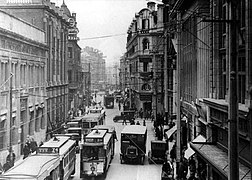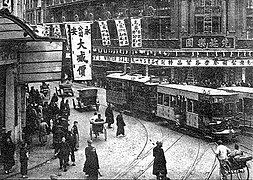
Changshu Road is an interchange station between lines 1 and 7 of the Shanghai Metro. It is situated in Shanghai's Xuhui District, within the inner ring-road. Furthermore, it provides access to the shopping street Huaihai Road, Shanghai Conservatory of Music as well as the former colonial neighborhood previously called The French Concession.

Xinzhuang is an interchange station on the Shanghai Metro. It is the southern terminus of Line 1 and the northern terminus of Line 5. It is one of the busiest stations in the Shanghai Metro, serving 230,000 passengers every day. Both Line 1 and Line 5's stations have two side platforms and two tracks, with a wall separating the Line 1 and the Line 5 platforms.

Jiangsu Road is the name of a station on lines 2 and 11 of the Shanghai Metro. This is one of the stations that can refund the 20RMB deposit for the Shanghai Public Transportation Card.
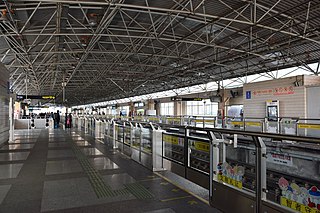
Caoyang Road is an interchange station between lines 3, 4, 11 and 14 of the Shanghai Metro, and is located in Putuo District.

Yishan Road is the name of an interchange station between Lines 3, 4 and 9 on the Shanghai Metro. It is the southernmost station shared by Line 3 and Line 4, although the two lines do not share tracks.

Hongqiao Road is an interchange station between Lines 3, 4 and 10 on the Shanghai Metro. It is the southernmost station of which Lines 3 and 4 share the same tracks. The station opened on 26 December 2000 as part of the initial section of Line 3 from Shanghai South Railway Station to Jiangwan Town, and Line 4 service began here on the final day of 2005. The interchange with Line 10 opened on 10 April 2010.

Zhenping Road is the name of an interchange station on the Shanghai Metro. It serves Lines 3, 4 and 7. The station typically handles 108,000 passengers on weekdays.
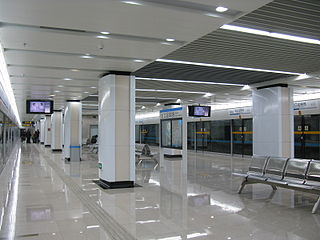
Hongkou Football Stadium is an interchange station between Lines 3 and 8 on the Shanghai Metro. The station opened on 26 December 2000 as part of the initial section of Line 3 from Shanghai South Railway Station to Jiangwan Town; the interchange with Line 8 opened on 29 December 2007 as part of that line's initial section from Shiguang Road to Yaohua Road.

Zhongshan Park is the name of an interchange station between Lines 2, 3 and 4 on the Shanghai Metro, named after Shanghai's largest commercial park which is located nearby. This station served as the western terminus of Line 2 from the line's opening on 20 September 1999 until the first westward extension to Songhong Road opened on 30 December 2006. The interchanges with Lines 3 and 4 opened on 27 December 2000 and the final day of 2005, respectively, and are part of both lines' initial sections. Immediately to the northeast of the station is the Cloud Nine shopping mall, visible from the elevated Lines 3 and 4.
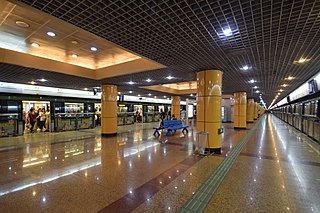
Jing'an Temple is the name of an interchange station between Lines 2, 7 and 14 of the Shanghai Metro. This station is located in Jing'an District, below the historic Jing'an Temple and the Jiu Guang shopping mall. It is part of the initial section of Line 2 that opened from Zhongshan Park to Longyang Road that opened on 20 September 1999; the interchange with line 7 opened on 5 December 2009 as part of that line's initial section between Shanghai University and Huamu Road and the interchange with line 14 opened on 30 December 2021.

People's Square is a large interchange station of the Shanghai Metro, located below People's Square, also next to People's Park and Nanjing Road, in the city center of Shanghai. The station is one of the busiest metro stations in mainland China, handling a daily traffic of over 700,000 passengers.

Zhangjiang Hi-Tech Park is a station on Line 2 of the Shanghai Metro. This station had been the line's eastern terminus from 27 December 2000, after an eastward extension from Longyang Road to Zhangjiang Hi-Tech Park opened, until 24 February 2010, when the line was extended further eastward to Guanglan Road. From 14 to 23 February 2010, this station was shut down, and Line 2 service terminated at Longyang Road, to allow for reconstruction work; the new underground Zhangjiang Hi-Tech Park station was built on the northeast side of the old, elevated station. This conversion allowed for greater compatibility with the 24 February 2010 opening of Jinke Road and Guanglan Road stations, which are both underground.
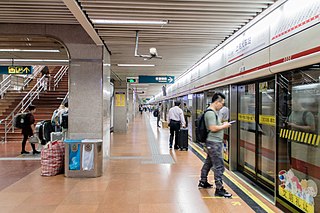
Shanghai Railway Station is an interchange station between lines 1, 3 and 4 on the Shanghai Metro. It is one of the stations where Line 3 and Line 4 share the same tracks and elevated platforms.

Shanghai South Railway Station is an interchange station between Lines 1, 3 and 15 of the Shanghai Metro. It is the southern terminus of Line 3.

Longhua Pagoda (龙华塔) is an octagonal wood and brick pagoda located in Xuhui District, Shanghai, East China. It is thought to have been first built during the Three Kingdoms period, but the existing tower structure was built during the Northern Song dynasty. The pagoda underwent several renovations over various dynastic periods, which resulted in the addition of several architectural features that were not in the typical style of the Song dynasty. After the establishment of the People's Republic of China, these later additions were removed and rebuilt in the Song dynasty style. Because of this, the pagoda has now been largely restored to its original appearance. The pagoda was twice established as a Shanghai Cultural Site Under State Protection, once on 26 May 1959 and again on 7 December 1997. On 25 May 2006, it was declared by the State Council to be among the sixth group of Major Historical and Cultural Sites Protected at the National Level.

Shanghai County was a Chinese county in modern-day Shanghai Municipality. Shanghai County was first established in 1292 and finally abolished in 1992. Shanghai County was for most of its existence a part of Songjiang Prefecture, in Jiangsu Province, but later became a county under Shanghai Municipality. Shanghai County was historically the governing authority of the Shanghai's urban area and neighbouring areas. Its extent reduced with the establishment of the Shanghai Special Municipality and, later, Shanghai Municipality. Immediately before abolition, the county extended over a crescent-shaped area adjacent to, and surrounding, the southwest of Shanghai's city centre.
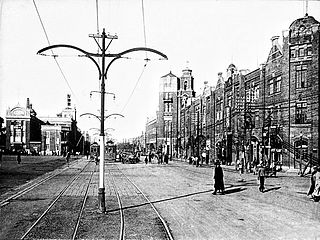
Shenyang, a major industrial city on the Hun River in northeast China has returned its tramway as a modern tram system. Shenyang once had a standard steel wheeled tramway network. Unlike other Chinese towns & cities, Shenyang's tram system was not opened directly as an electric tram. The tram service was completely stopped in 1973. On 15 August, 2013 Shenyang opened a modern tram system in Hunnan New District south of central Shenyang.

The Shanghai Ferry is a system of ferry routes across the Huangpu River in Shanghai. The ferry service started on January 5, 1911 by the municipal authorities in Pudong. Before the 1970s, the ferry service was the only way to cross the Huangpu River. In the 1980s, the Shanghai Ferry became one of the busiest ferry services in the world. In the 1990s, as bridges and tunnels across the Huangpu river were built, the ferry service saw a sharp drop in ridership. The Shanghai Ferry currently consists of 18 ferry lines and is operated by the state-owned Shanghai Ferry Company.

Songpu Bridge, first known as Huangpu River Bridge, Cheting Bridge, is the first bridge built across the Huangpu River in Shanghai, China. It is a double-layer steel truss bridge for highway and railway across the Huangpu River in Songjiang District. The Songpu Bridge Railway Bridge and Highway Bridge were opened to traffic on September 11, 1975 and June 29, 1976, respectively. For a long time after its completion, it was also the only bridge on the upper reaches of the Huangpu River until the opening of the Huangpu River Bridge on the G15 Shenhai Expressway in 2006.
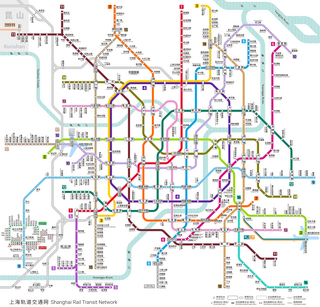
Shanghai Rail Transit includes all rail transit lines operating in Shanghai, mainly composed of High-volume railway system, Low-to-medium-volume railway system and Maglev system. The system was established on May 28, 1993, when Shanghai Metro Line 1 opened.

